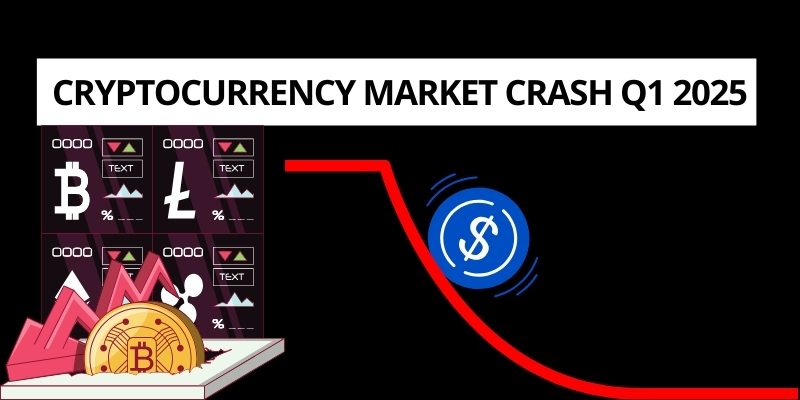Cryptocurrency Market Crash Q1 2025: A $663 Billion Wipeout
The cryptocurrency market crash in the first quarter of 2025 has sent shockwaves through the global financial ecosystem, erasing $663 billion in market capitalization, a staggering 18.6% decline, according to a recent CoinGecko report. This unprecedented downturn, driven by macroeconomic pressures, regulatory uncertainties, and high-profile security breaches, has transformed early-year optimism into widespread apprehension. Despite fleeting moments of resilience, the market’s trajectory underscores a sobering reality: the crypto industry remains highly vulnerable to external forces.
Contents
A Promising Start Derailed by Macroeconomic Headwinds
The year began with a surge of enthusiasm, fueled by expectations of crypto-friendly policies following Donald Trump’s inauguration. The cryptocurrency market crash, however, quickly overshadowed this optimism. Bitcoin, the industry’s bellwether, initially rode the wave of bullish sentiment, bolstered by speculation around favorable regulations. Meme coins, particularly the Solana-based TRUMP token, sparked frenzied trading activity in January. Yet, the euphoria was short-lived. The TRUMP token plummeted, and the broader market followed suit, exacerbated by the LIBRA scandal, which further eroded investor confidence.

CoinGecko’s data paints a grim picture: the total market capitalization contracted by 18.6%, equivalent to $663 billion, in just three months. Bitcoin, despite maintaining its dominance at 59.1% of the market, was not spared, declining 11.8%—a performance that lagged behind traditional safe-haven assets like gold and U.S. Treasury bonds. Ethereum fared even worse, with its entire 2024 gains wiped out. The cryptocurrency market crash was not merely a price correction but a systemic unraveling, driven by a confluence of adverse factors.
Investor Sentiment: From Euphoria to Despair
The cryptocurrency market crash profoundly impacted investor behavior. Daily trading volumes plummeted by 27.3% compared to Q4 2024, reflecting a sharp decline in market participation. Spot trading on centralized exchanges dropped 16.3%, a decline partially attributed to the high-profile Bybit hack, which shook trust in platform security. The DeFi sector, often touted as a pillar of crypto innovation, saw its total value locked (TVL) across multi-chain protocols shrink by 27.5%. Solana, a leading DeFi ecosystem, lost over one-fifth of its TVL, underscoring the sector’s vulnerability to market downturns.
Trump’s tariff policies, which disrupted global trade and depressed Treasury bond yields, indirectly compounded the cryptocurrency market crash. Unlike traditional markets, where bonds offered a hedge, crypto assets proved far more volatile. The sell-off was further intensified by a “sell-the-news” phenomenon, as investors, disappointed by unmet expectations of regulatory clarity, liquidated positions en masse.
Pockets of Resilience Amid the Carnage
Despite the gloom, the CoinGecko report highlights glimmers of hope. Bitcoin exchange-traded funds (ETFs) attracted $1 billion in fresh inflows, signaling sustained institutional interest. Solana’s decentralized exchange (DEX) ecosystem continued to outperform competitors, cementing its position as a DeFi leader. However, these positives were overshadowed by broader market challenges. The total assets under management (AUM) for crypto funds dropped by nearly $9 billion due to falling prices, and ETF yields faltered as asset values declined. The cryptocurrency market crash thus exposed the fragility of even the most promising segments of the industry.
A Perfect Storm of Challenges
The Q1 2025 cryptocurrency market crash was precipitated by a perfect storm of macroeconomic, regulatory, and operational challenges. Trump’s tariffs destabilized global markets, creating ripple effects that dampened risk appetite. The Bybit hack, one of the largest in recent history, highlighted ongoing security risks in centralized exchanges. Regulatory pressures, including scrutiny of stablecoins and DeFi protocols, further clouded the market’s outlook. The LIBRA scandal, though specifics remain murky, added to the narrative of distrust, prompting retail and institutional investors alike to scale back exposure.
The decline in DeFi TVL and trading volumes reflects a broader crisis of confidence. Investors, once emboldened by the promise of decentralized finance, grew cautious as losses mounted. The cryptocurrency market crash also underscored the sector’s sensitivity to macroeconomic indicators, with fears of a global recession looming large. Unlike previous cycles, where Bitcoin and altcoins rebounded swiftly, the current downturn suggests a more protracted recovery.

The cryptocurrency market crash of Q1 2025 serves as a stark reminder of the crypto industry’s volatility and interconnectedness with global economic trends. For investors, the path forward demands vigilance and strategic discipline. Monitoring macroeconomic developments, such as interest rate policies and trade dynamics, will be critical. Regulatory clarity, particularly in the U.S., could provide a lifeline, but uncertainties persist. Security enhancements across exchanges and DeFi platforms are also essential to restore trust.
While Bitcoin’s dominance and ETF inflows offer some stability, the broader market remains precarious. Altcoins, particularly those tied to speculative narratives, face heightened risks. Investors should prioritize diversification, focusing on assets with strong fundamentals and utility. The cryptocurrency market crash may have exposed weaknesses, but it also presents opportunities for those who can navigate the volatility with foresight and resilience.
Conclusion
The $663 billion cryptocurrency market crash in Q1 2025 marks a pivotal moment for the crypto industry. What began as a year of promise quickly descended into one of the most severe corrections in recent memory. Macroeconomic disruptions, security breaches, and regulatory headwinds have tested the resilience of investors and the industry alike. While pockets of innovation, such as Bitcoin ETFs and Solana’s DEX dominance, offer hope, the road to recovery will be challenging. By staying informed and adopting a cautious yet opportunistic approach, investors can position themselves to weather the storm and capitalize on the next wave of growth in the ever-evolving crypto landscape.